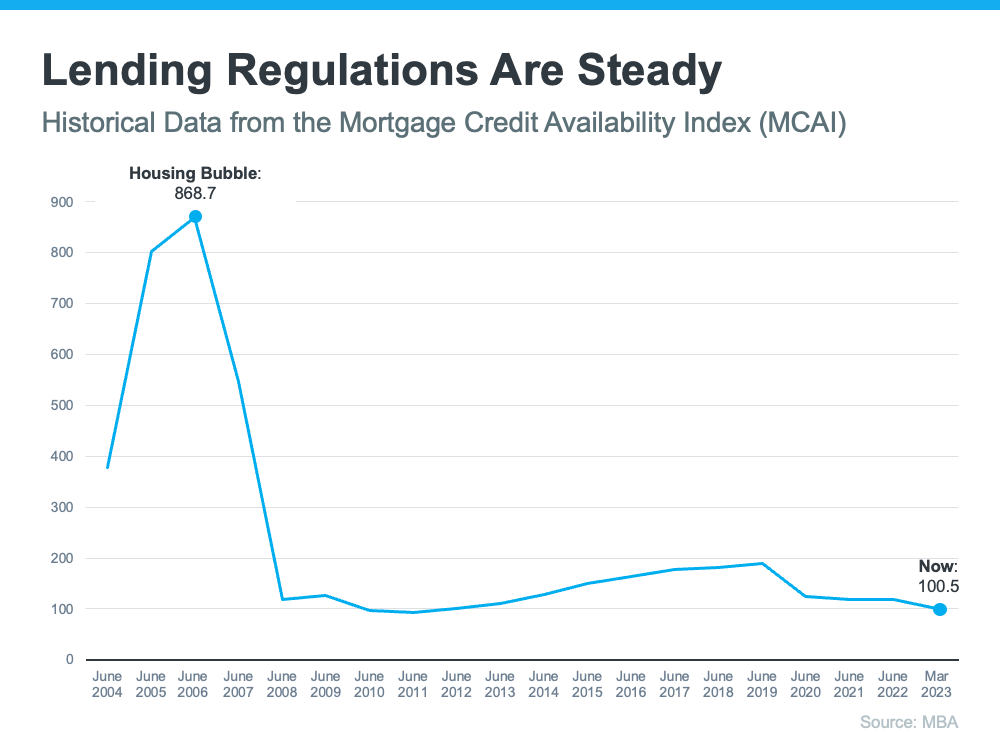Why Today’s Housing Market Is Not About To Crash
Lisa Mailhot | May 17, 2023

Lisa Mailhot | May 17, 2023

There’s been some concern lately that the housing market is headed for a crash. And given some of the affordability challenges in the housing market, along with a lot of recession talk in the media, it’s easy enough to understand why that worry has come up.
But the data clearly shows today’s market is very different than it was before the housing crash in 2008. Rest assured, this isn’t a repeat of what happened back then. Here’s why.
It was much easier to get a home loan during the lead-up to the 2008 housing crisis than it is today. Back then, banks had different lending standards, making it easy for just about anyone to qualify for a home loan or refinance an existing one. As a result, lending institutions took on much greater risk in both the person and the mortgage products offered. That led to mass defaults, foreclosures, and falling prices.
Things are different today as purchasers face increasingly higher standards from mortgage companies. The graph below uses data from the Mortgage Bankers Association (MBA) to show this difference. The lower the number, the harder it is to get a mortgage. The higher the number, the easier it is.
 Unemployment Recovered Faster This Time
Unemployment Recovered Faster This TimeWhile the pandemic caused unemployment to spike over the last couple of years, the jobless rate has already recovered back to pre-pandemic levels (see the blue line in the graph below). Things were different during the Great Recession as a large number of people stayed unemployed for a much longer period of time (see the red in the graph below):
Here’s how the quick job recovery this time helps the housing market. Because so many people are employed today, there’s less risk of homeowners facing hardship and defaulting on their loans. This helps put today’s housing market on stronger footing and reduces the risk of more foreclosures coming onto the market.
There were also too many homes for sale during the housing crisis (many of which were short sales and foreclosures), and that caused prices to fall dramatically. Today, there’s a shortage of inventory available overall, primarily due to years of underbuilding homes.
The graph below uses data from the National Association of Realtors (NAR) and the Federal Reserve to show how the months’ supply of homes available now compares to the crash. Today, unsold inventory sits at just a 2.6-months’ supply. There just isn’t enough inventory on the market for home prices to come crashing down like they did in 2008.
That low inventory of homes for sale helped keep upward pressure on home prices over the course of the pandemic. As a result, homeowners today have near-record amounts of equity (see graph below):
And, that equity puts them in a much stronger position compared to the Great Recession. Molly Boesel, Principal Economist at CoreLogic, explains:
“Most homeowners are well positioned to weather a shallow recession. More than a decade of home price increases has given homeowners record amounts of equity, which protects them from foreclosure should they fall behind on their mortgage payments.”
The graphs above should ease any fears you may have that today’s housing market is headed for a crash. The most current data clearly shows that today’s market is nothing like it was last time.

Not ready to buy a home? Ask yourself these 5 critical questions first. Get expert guidance to make your homebuying decision with confidence.

Discover why the 2026 housing market presents unique opportunities for buyers and sellers in Orange County with favorable trends and economic conditions.

Your house didn't sell? Discover proven strategies to reposition your property, adjust pricing, and attract serious buyers in today's market.

Buyer demand is strengthening across real estate markets nationwide. Learn what this shift means for sellers and how to capitalize on renewed interest today.

Top 10 U.S. housing markets are set to rebound in 2026, fueled by millennial buyers. See how affordability, inventory, and mortgage rates are creating opportunities fo… Read more

Housing listings are declining as buyers and sellers pause. See what the slowdown means for Orange County’s real estate market in late 2025.

Why savvy buyers choose January for home purchases. Lower prices, motivated sellers, and less competition make winter the strategic time to buy.

Mortgage rates are down and buyer demand is surging. Learn why now is the perfect time to list your home and capitalize on market momentum.

New home listings fell 1.7% in December 2025, creating opportunities for sellers. Discover what this cooling market means for your real estate strategy.
Let's find a time that suits you best to chat about your goals, show you how we work, and figure out how we can help you the most